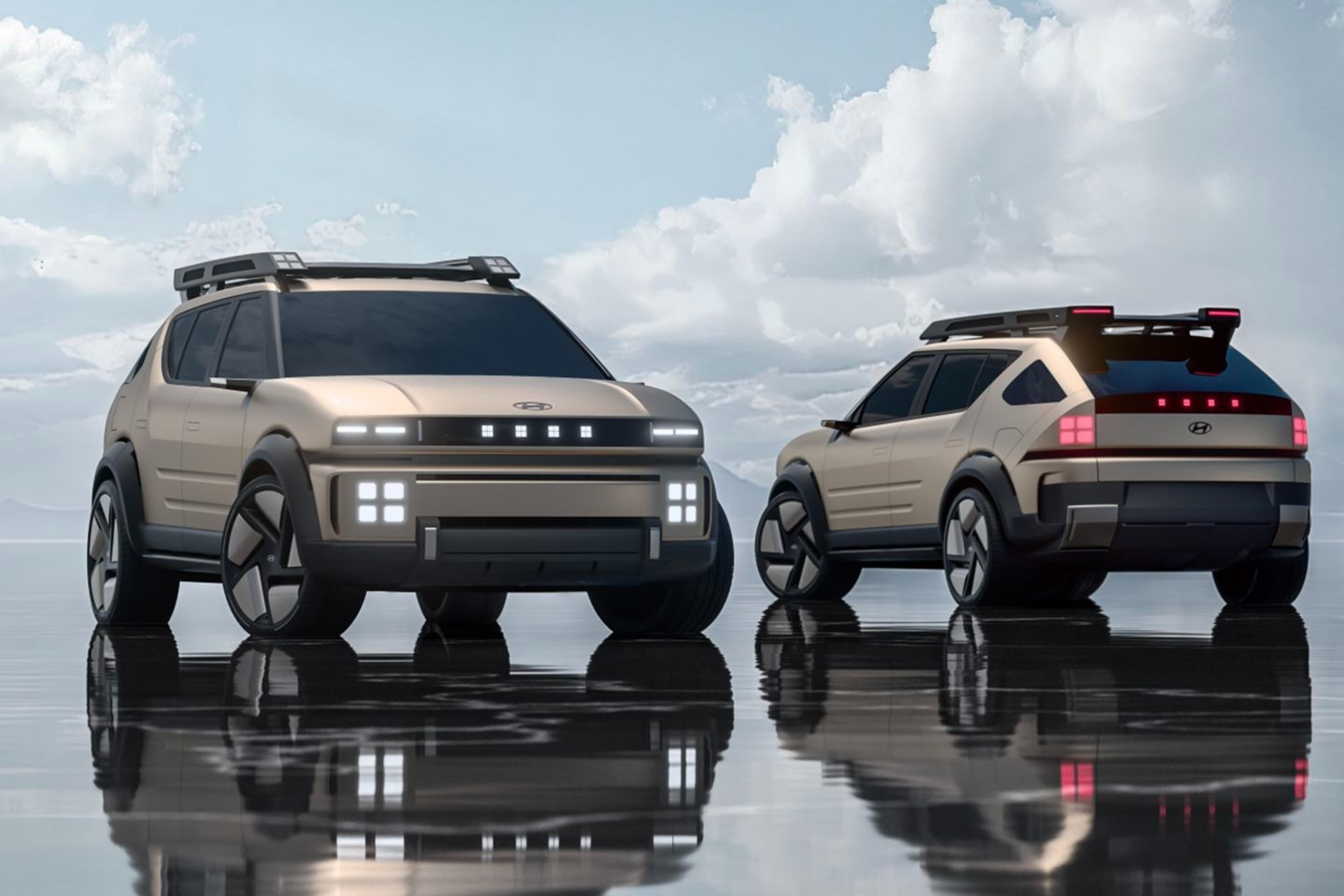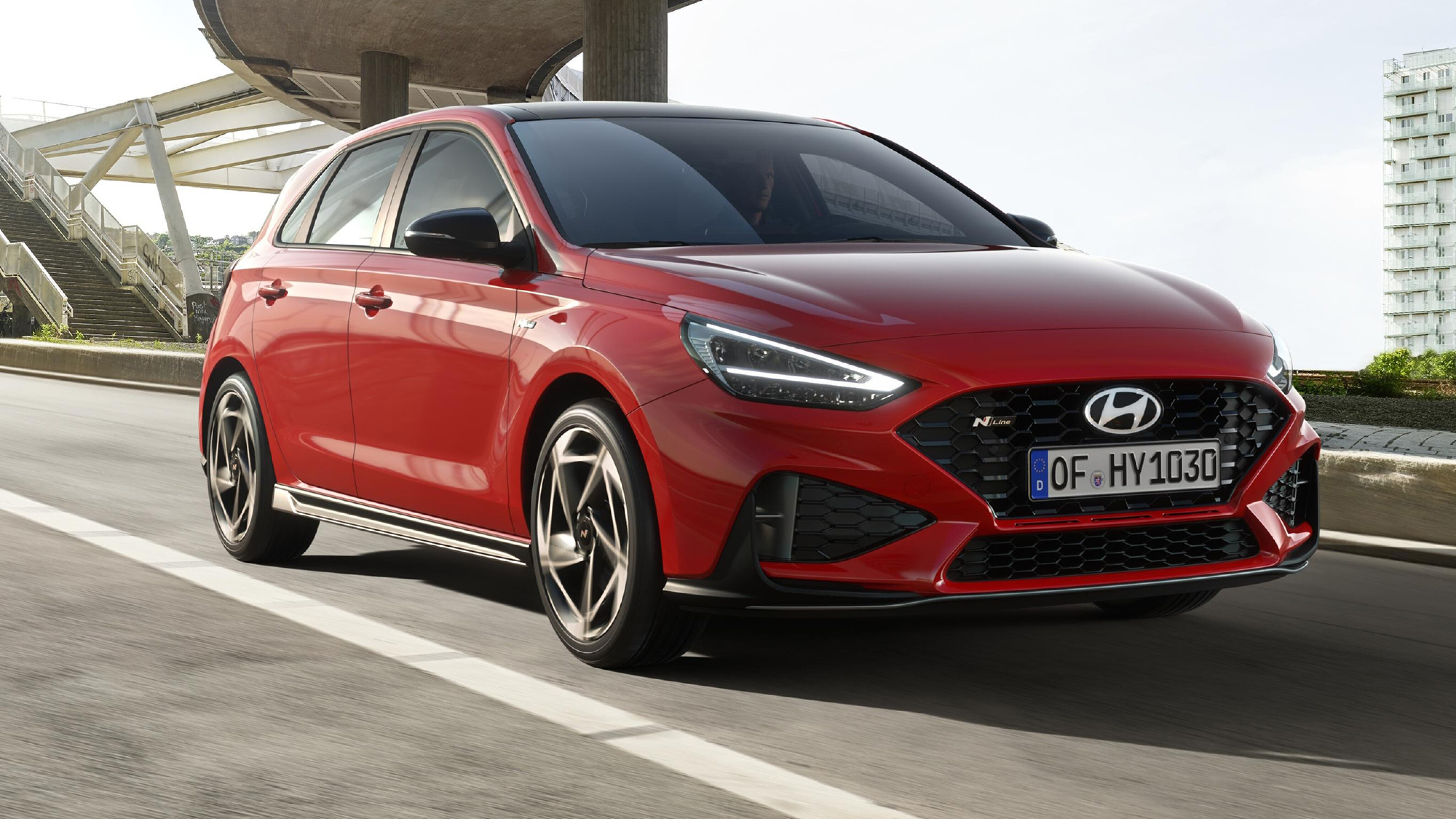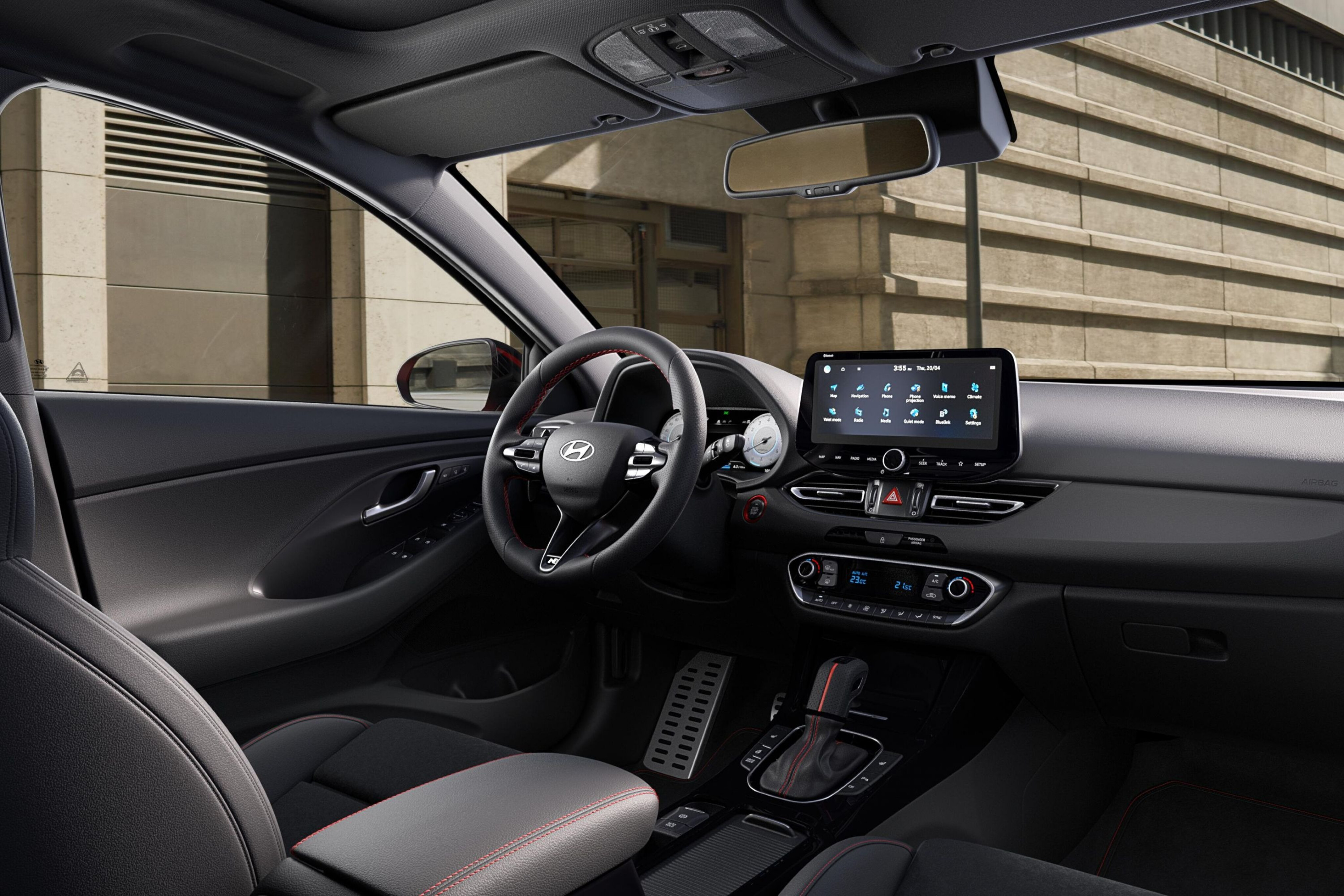
A hugely expanded Ioniq EV range, the next Nexo, Casper's electric cousin, a HiLux-rivalling ute, and – finally! – the Vision 74!
Hyundai, one of the world's biggest car makers, isn't about to get complacent as its product-planning department continues its relentless pace.
2024 has been a big one for Hyundai showrooms, with updates for the i30 small car and Tucson midsized SUV (two of its biggest-selling models), a new-generation Santa Fe large SUV, and its first ever all-wheel-drive/electric N car.
Along with new more affordable Ioniq EV models, next year will bring the huge Ioniq 9, the compact Inster EV and a production version of the Vision 74.
And, if whispers prove true, 2024 may be the year Hyundai finally reveals official details of its first-ever Toyota Hilux rival.

JUMP AHEAD
Confirmed & arrived models
- Hyundai i30 (facelift)
- Hyundai i30 Sedan (hybrid and N facelift)
- Hyundai Tucson (facelift and Hybrid)
- Hyundai Santa Fe
- Hyundai Ioniq 5 (facelift)
- Hyundai Ioniq 5 N
Future models
- Hyundai Inster EV
- Hyundai Vision 74
- Hyundai Ioniq 3
- Hyundai Ioniq 4
- Hyundai Ioniq 6 N
- Hyundai Ioniq 9
- Next Tucson
- Hyundai Electric Ute
- Next Nexo
- Palisade
Confirmed & here now

i30 Hatch
The 2025 Hyundai i30 Hatch has undergone significant changes, with a shift to Czech production introducing a five per cent import duty and the elimination of lower trims like the Active and Elite.
The remaining N Line and N Line Premium variants now start at $36,000 and $41,000 before on-road costs, marking a $12,000 increase for the base model compared to the previous entry-level price. These updates place the i30 Hatch at a higher price point than before, with the N Line Premium costing $3700 more than its 2024 equivalent.
The new model adopts a turbocharged 1.5-litre four-cylinder engine with a 48V mild-hybrid system, producing 117kW and 253Nm. This engine, paired exclusively with a seven-speed dual-clutch automatic transmission in Australia, replaces both the naturally aspirated 2.0-litre unit and the more powerful 1.6-litre turbocharged engine from previous N Line models.

Despite lower outputs compared to the outgoing 1.6-litre, the new engine delivers improved fuel economy, claiming 5.6L/100km on the combined cycle. Multi-link rear suspension continues as a standard feature for the N Line trims.
Styling updates include refreshed LED headlights, tail lights, and LED interior lighting. These enhancements bring the N Line models in line with European versions, addressing discrepancies from the last facelift in 2020.
The pricing shift positions the i30 Hatch in a more premium bracket, leaving the more affordable Korean-built i30 Sedan—starting at $29,000 before on-roads—as the brand's budget-friendly option.
For those seeking more performance, the sedan retains its 1.6-litre turbocharged engine in the N Line variant, priced similarly to the base i30 Hatch N Line.
i30 Sedan
The refreshed i30 Sedan arrived earlier this year, and now Hyundai has extended its nationwide drive-away pricing until the end of November.
The entry-level i30 Sedan is now available at $29,990 drive-away, reflecting a discount between $2400 and $3300, depending on the state or territory.
Other models in the line-up also benefit from reduced pricing, with the flagship N Line Premium offered at $44,990 drive-away, approximately $1000 less than the standard price.
Equipment highlights
i30 Sedan: 16-inch alloy wheels, automatic LED headlights, 8.0-inch touchscreen infotainment system with Apple CarPlay and Android Auto, wireless phone charger, and a suite of safety features including autonomous emergency braking and adaptive cruise control.
i30 Sedan Elite: Adds 17-inch alloy wheels, 10.25-inch digital instrument cluster, 10.25-inch touchscreen with satellite navigation, Bluelink connected services, dual-zone climate control, leather upholstery, and additional safety aids like blind-spot assist and rear cross-traffic assist.
i30 Sedan N Line: Features a turbocharged 1.6-litre engine, 18-inch alloy wheels, N Line exclusive exterior and interior styling, multi-link rear suspension, and sport seats with leather bolsters.
i30 Sedan Premium: Includes a tilt and slide glass sunroof, projector LED headlights, eight-speaker Bose sound system, heated and ventilated front seats, and advanced safety features such as rear autonomous emergency braking and a surround-view camera.
At the time of reporting, Hyundai has around 1500 examples of the i30 Sedan currently in Australian stock, which should get cars into buyers' hands quickly.
The base, Elite, and Premium models are powered by a 2.0-litre four-cylinder engine, while the N Line variants are equipped with a more powerful turbocharged 1.6-litre engine.
According to Korea's ET News, a new-generation i30 Sedan, codenamed 'CN8', will debut in 2026, with petrol and hybrid powertrains again on offer.
Tucson
The refreshed 2025 Hyundai Tucson arrived in June, introducing revised looks, a new hybrid powertrain and updated safety features.
The previous 2.0-litre turbo-diesel engine has been discontinued, replaced by a petrol-electric hybrid system delivering 172kW and 264Nm. The existing 2.0-litre petrol engine (115kW/192Nm) and 1.6-litre turbo-petrol engine (132kW/264Nm) remain available.
The 2025 Tucson is offered in three trim levels: Base, Elite, and Premium (formerly Highlander). Pricing starts at $39,990 for the 2.0-litre petrol FWD Base model and reaches $59,600 for the Premium 1.6-litre turbo-petrol hybrid AWD variant. An optional N Line package is available, adding features such as exclusive 19-inch wheels, a unique grille, and sportier exterior and interior elements.
Notable updates include a redesigned front bumper and grille, standard LED lighting across all variants, dual 12.3-inch touchscreens in the interior, and an enhanced suite of safety technologies.
Safety enhancements encompass increased body rigidity, second-row seatbelt pretensioners, and advanced driver assistance systems like Forward Collision-Avoidance Assist 1.5 with junction turning function, Highway Driving Assist, and Blind-Spot Collision Avoidance Assist.
Santa Fe
The new 2024 Hyundai Santa reached Australia in May, offering a hybrid-only line-up across three variants: Santa Fe, Elite, and Calligraphy.
The base Santa Fe model is available in front-wheel drive at $55,500 and all-wheel drive at $58,500. The Elite variant, priced at $65,000, and the top-tier Calligraphy, starting at $75,000, are both all-wheel drive. The Calligraphy offers a six-seat configuration with second-row captain’s chairs for an additional $500, bringing its price to $75,500.
All variants are powered by a 1.6-litre turbocharged petrol-electric hybrid engine, delivering 172kW and 367Nm, paired with a six-speed automatic transmission.
The combined fuel consumption is rated at 5.6L/100km. Standard features across the range include seven seats (with the six-seat option in the Calligraphy), 20-inch wheels, dual 12.3-inch infotainment screens, and over-the-air update capability.
The Elite variant adds features such as ambient lighting, a 12-speaker Bose audio system, satellite navigation, and twin wireless charging pads. The Calligraphy variant further includes a head-up display and a digital rearview mirror. Safety features standard across all models encompass 10 airbags, autonomous emergency braking, blind-spot and lane-keep assist, fatigue detection, radar cruise control, speed-sign recognition, and rear cross-traffic alert with braking.
Ioniq 5
July brought us the 2025 Ioniq 5 electric SUV, introducing design changes, safety enhancements, and increased driving range.
The 2025 Ioniq 5 now features redesigned front and rear bumpers, an extended rear spoiler, and new 19- and 20-inch alloy wheels. An optional N Line package is available for the Dynamiq and Epiq variants, adding exclusive bumpers, gloss black mirror housings, and specific 20-inch wheels.
The interior has been updated with a revised centre console that includes controls for seat heating and ventilation. The infotainment system now supports wireless Apple CarPlay and Android Auto.
Safety features have been enhanced with forward collision avoidance, smart cruise control, and intelligent front lighting.
The 2025 Ioniq 5 offers two battery options: a 63kWh battery for the Standard Range variant, providing a WLTP range of 440km, and an 85kWh battery for the Extended Range variant, offering up to 570km.
The Standard Range model delivers 125kW and 350Nm, while the Extended Range provides 168kW and 350Nm.
Pricing starts at $69,800 for the Standard Range 2WD, with the Extended Range 2WD priced at $75,800, and the Extended Range AWD at $85,300.
Ioniq 5 N
Hyundai introduced the 2024 Ioniq 5 N to Australia in February, marking its first high-performance electric vehicle under the N division.
Priced at $111,000 before on-road costs, this model is positioned above the standard Ioniq 5 variants.
The Ioniq 5 N is equipped with dual electric motors delivering a combined output of 478kW and 770Nm in 'N Grin Boost' mode, enabling acceleration from 0 to 100 km/h in 3.4 seconds.
It features an 84.0kWh battery, all-wheel drive, and a reinforced chassis for enhanced handling.
Standard features include 21-inch alloy wheels with Pirelli P Zero tyres, a 12.3-inch digital instrument cluster, a 12.3-inch infotainment touchscreen, and a head-up display.
Safety systems encompass autonomous emergency braking, blind-spot monitoring, lane-keeping assist, and adaptive cruise control.
Future models
Next-generation Tucson
Hyundai’s popular Tucson will continue to play a central role in the brand’s global line-up as it transitions to its next generation, expected in the first half of 2026.
Known internally as the NX5, the redesigned Tucson will continue with its petrol, hybrid, and plug-in hybrid powertrain options, aligning with Hyundai’s strategy to extend the lifespan of internal combustion engine (ICE) vehicles into the 2030s.
There's no official news on the new model yet, but Korean website ET News claims the next Tucson will feature improved powertrain performance and the latest Hyundai safety technologies.
As for styling, we can likely expect the recently launched new Santa Fe (see below) to influence the design of the next Tucson.
The current Tucson, which first launched in 2020 and received a facelift earlier this year, is Hyundai’s best-selling vehicle in Australia, with 16,200 deliveries recorded to the end of October 2024.
Casper Inster EV
This baby Hyundai already existed as a three-cylinder petrol city car known as Casper, but this year brought the debut of an electric companion: the Inster.
Hyundai's smallest and most affordable new EV will reach Australia in early 2025, and while pricing is still to be confirmed, leaked details suggest a drive-away price in the low $40K range.
The Inster will be available in two configurations, with a driving range beyond 300km in base form and over 355km in top-spec form.
It's a properly little thing, too. Tthe Inster measures 3825mm in length, 1610mm in width, and 1575mm in height, with a wheelbase of 2580mm. This positions it as a compact SUV, smaller than the already small Hyundai Venue, yet offering a longer wheelbase.
Read more about the Inster at the linked story above.
Finally, at last: Vision 74
In August, Hyundai confirmed the N Vision 74 concept car will enter limited production, with 100 units planned, suggesting an entirely hand-built run.
Of these, 70 will be available to the public, and 30 will be reserved for racing purposes. The hydrogen hero is expected to deliver over 550kW, with production anticipated to begin in 2026.
The N Vision 74 draws design inspiration from the 1974 Hyundai Pony Coupe Concept, blending retro aesthetics with modern technology.
It is part of Hyundai's broader strategy to expand its electric vehicle lineup, which includes plans to release 21 new models by 2030, encompassing economy, luxury, and high-performance segments.
Pricing for the N Vision 74 is expected to start at £284,000, reflecting its limited production and advanced technology. The vehicle's development underscores Hyundai's commitment to innovation in the high-performance electric vehicle market, combining hydrogen fuel cell technology with a distinctive design heritage.
Ioniq 3
Affiliate company Kia has already unveiled a range of upcoming smaller EVs such as the EV3 and EV4, yet Hyundai has been strangely silent for its production plans below the midsized Ioniq 5.
Current industry intel is that the Ioniq 3 will be a subcompact crossover, which would help ensure it doesn't tread on the toes of the recently introduced second-generation electric Kona compact SUV (4.35 metres long).
A crossover body style – part SUV, part hatch – would make the Ioniq 3 a natural rival for the likes of the BYD Dolphin, Cupra Born and MG4. The Ioniq 3, however, may not be seen for a good couple of years.
Ioniq 4
As the badge suggests, the Ioniq 4 will sit between the Ioniq 3 and Ioniq 5 in the showroom pecking order.
Odd numbers SUVs, even numbers sedans... That seems to be Hyundai's approach anyhow, as the Ioniq 4 is expected to be a smaller sibling to the Ioniq 6 electric sedan.
Renowned US industry journal Automotive News has suggested the Ioniq 4 will make a production debut in 2026.
Hyundai's mastermind behind the N performance division has already confirmed there will be a smaller N model to sit beneath the $111K-plus Ioniq 5 N.
For enthusiasts on smaller budgets, the hope will be for both Ioniq 3 N and Ioniq 4 N models.
Ioniq 6 N
Hyundai hasn't officially confirmed it, but an N version of the Ioniq 6 is coming – and has already been previewed by the RN22e concept (see story above).
The regular versions of the Ioniq 5 and 6 are closely related, so the 6 N can be expected to share all its fundamental components with the 5 N.
It could gain extra power over its crossover sibling, while we're also expecting the 6 N to adopt the twin-clutch rear differential showcased in the RN22e - which can shuffle torque up to 100 per cent to an individual rear wheel.
Ioniq 7 Ioniq 9
Prototypes of Hyundai's electric large SUV have been spied on the road, following the reveal of the Seven concept in 2021.
In October 2024, Hyundai released teaser images of what will now be known as the Ioniq 9.
Still a three-row electric SUV, the 9 will make its global debut in November.
As expected, the Ioniq 9 continues the design language of the 'Seven' concept, featuring a 3200mm wheelbase and utilizing Hyundai's E-GMP electric architecture, which is shared with Kia EVs.
The Ioniq 9 is expected to offer a driving range exceeding 480 kilometers, supported by 800V charging technology that enables a 10 to 80 percent battery charge in approximately 20 minutes when using a 350kW charger.
Electric ute
Hyundai already sells a ute called the Santa Cruz in the US, though it's left-hand-drive only and more of a car-based lifestyle vehicle than workhorse.
The company, however, is working on a commercial-focused dual-cab vehicle – a model Hyundai Australia would dearly love to help it take a slice of a huge segment currently dominated by the Ford Ranger and Toyota HiLux.
Partner company Kia has revealed the polarising Tasman ute, but Wheels understands Hyundai will skip combustion engines and go directly to electric propulsion for its version.
Hyundai has again been very tight-lipped about this vehicle, so concrete details remain scarce.
Next-gen Nexo hydrogen SUV
Rather than giving up, Hyundai is advancing its hydrogen fuel-cell vehicle (FCEV) technology with the development of the next-generation Nexo SUV.
In terms of design, the current model's fluid design is expected to give way to a more angular, boxy aesthetic, reminiscent of the Initium concept unveiled earlier this year (pictured below). This design evolution aligns with Hyundai's broader strategy, as seen in the 2024 Santa Fe's redesign.
While specific powertrain details for the new Nexo remain undisclosed, the existing model features a hydrogen fuel tank with a capacity of 6.33kg, a 95kW fuel cell stack, a 1.56kWh battery, and a 120kW electric motor.

The Initium concept, which may influence the upcoming Nexo, is equipped with larger hydrogen tanks, a higher-output fuel cell stack, an enhanced battery, and a 150kW electric motor.
Hyundai targets a driving range exceeding 650km for the production version, compared to the current Nexo's 666km range under WLTP testing.
Hyundai has been investing in hydrogen fuel-cell technology for 27 years, with the Nexo being its latest FCEV, first introduced in 2018 and arriving in Australia in 2020 – albeit in limited numbers, available only through special business leases.
Next-gen Palisade
Hyundai is understood to be planning the launch of its next Palisade, with an anticipated debut in 2025.
The second generation of Hyundai's big family SUV is expected to feature a more angular design, aligning with the styling direction introduced with the 2024 Santa Fe.
Under the lid, the new Palisade is likely to offer a range of powertrains, including hybrid and plug-in hybrid options, packaged in an updated version of the current model's platform.
Additionally, improvements in interior space and technology are expected, with a focus on providing a more comfortable and connected driving experience.
Watch for more on that one in the coming months.
WhichCar thanks Jez Spinks for the original version of this story.
COMMENTS